|
Ethics is important to consider in all aspects of our lives. One area that is often overlooked in ethical decision making is agriculture. Especially in California it is paramount that ethics are incorporated in the agricultural industry as the state produces nearly half of the fruits, nuts, and vegetables for the nation. Two especially important areas that need to be addressed are water and pesticide use. Water is becoming an increasingly scarce resource, as climate change threatens its availability and distribution. In 2014, for the first time ever, the Federal Government has cut off federally supplied irrigation water to most farm districts in the Central Valley. From an environmental justice standpoint humans have a right to clean water to address their needs, and this is often threatened by current agricultural processes. The environment also has a claim to water, which is a source of life for California ecosystems. Similarly, many farmers and consumers in California are detrimentally affected by the excessive use of pesticides to grow the food we eat. It is important to use ethical decision making in such an important aspect of our daily lives. The information here documents the ethical implications of some of the most common California-grown crops, specifically focused on issues related to water and pesticide use. 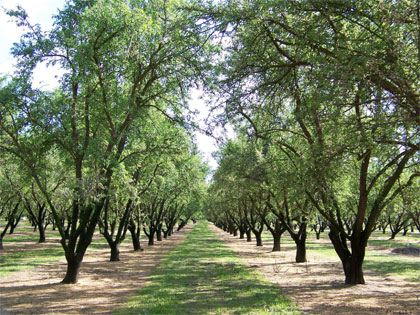 Almond Orchard, Winton, California, Wikimedia Commons (Nehrams2020) 1. Almond (Prunus dulcis)Almonds are California's number one food export. In fact California produces 82% of the world's almonds. Yet almonds are water-intensive to grow, and California does not have enough water. In a normal year of unrestricted water use an almond tree will use about 41-44 inches of water. The Westland Water District in the Central Valley allocates nearly 100 billion gallons of water a year for the almond orchards; this is what it takes to support a $2.5 billion dollar export industry. Almond trees do not do well in drought, and the coming years will likely see a disaster if more water does not come to the Central Valley. The case of almonds is a compelling example of how crops better suited for drought should be preferred over those which are less resilient. In terms of pesticide use, in 2009 the California almond industry used an astonishing 18 million pounds of chemicals. These chemicals can be very hazardous for human health. The Central Valley of California has the greatest number of reported pesticide poisonings, with 48% of all reported cases between 1997 and 2000. It seems unethical that our food system is poisoning the workers who grow the food that we eat. 
Apples, Wikimedia Commons (Sven Teschke) 2. Apple (Malus domestica)Worldwide, more than 7,500 varieties of apple are grown, and about 2,500 of these are grown in the United States (AgMRC). Apples are one of the most valuable fruit crops in the United States, and Washington State produces about 70% of U.S. apples. Other leading apple producing states include New York, Pennsylvania, California, and Virginia. Combining fresh and processed consumption, apples are the second most consumed fruit after oranges. In 2012, the average American consumed, in various forms, about 44 pounds of apples (AgMRC). Apple trees, like most fruit trees, require large amounts of water in order to thrive. According to one study, apple trees use the most water in July because the tree's canopy has reached 80–90 percent of its full shape and the fruit are developing very rapidly. Daily water use per tree showed peak values around 35–40 liters (10.5 gallons)/day per tree during this time, and then gradually declined (Dragoni et al., 2003). Other researchers discovered that the apple trees consumed 70 liters (18 gallons) of water per day during the middle of summer, and then daily water use declined to about 20 liters (5.2 gallons) per day during the fall ( Green et al., 2003). Insecticides, fungicides, and herbicides are all used in US apple production in major apple growing states. According to the USDA, "approximately 81% of conventional apple acres received treatment with at least one organophosphate pesticide to control insect pests." In 1989, the apple industry faced one of its largest consumer health scares over the use of Alar (the brand name of the chemical plant growth regulator Daminozide) during crop production. Alar is sprayed onto apples to enhance their color and make harvest easier. The EPA determined that long term exposure to Alar had potential health risks, which caused apple prices to decline and revenue to fall almost $140 million that season once the media showcased the dangers of the chemical. Apple prices rebounded after Alar manufactures voluntarily stopped Alar distribution (USDA). Across the nation, conventional producers are reducing pesticide use with apple production. In 2012 the EPA banned the use of Azinphos-methyl, which posed "unacceptable risks for farmworkers and caused fish kills when sprayed over water." However, a 2011 USDA survey found that 98% of apples contained pesticide residues, but were still within amounts that federal regulators consider safe to eat. Biological pest management practices and products, such as pheromone traps and floral lures, are also used in both organic and conventional apple production to reduce pest populations. 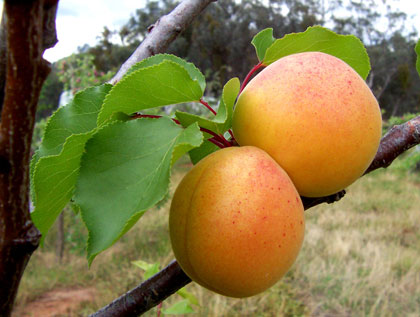
Apricots, Wikimedia Commons (Fir0002) 3. Apricots (Prunus armeniaca and related varieties)Apricots are a Mediterranean crop and require a warm, dry growing season. Any location with warm, dry springs and summers and sufficient water availability is able to produce apricots. Historically, apricots have been grown throughout the Central Valley and in other California valleys such as Santa Clara County. Around 90% of the apricots grown in the United States come from California. In the U.S. in 2012 there were 12,150 apricot bearing acres, yielding about 5.46 tons per acre, and apricot exports were valued at almost $20.2 million (AgMRC). According to University of California researchers, a mature apricot orchard can consume up to 40 acre-inches of water per season in the Central Valley. Peak water use in midsummer is about 0.3 inch per day. In Santa Clara County, apricots will use about 37 acre-inches per year: approximately 13 inches of rainfall and 24 acre-inches of irrigation. Apricots are susceptible to many pests. Some farmers will choose to use pheromone traps, however insecticides such as carbaryl are often used to treat insects and mites. Carbaryl is a cholinesterase inhibitor (a broad-spectrum neurotoxin) and in addition to being poisonous to humans, according to the United States Environmental Protection Agency, it is also likely carcinogenic. 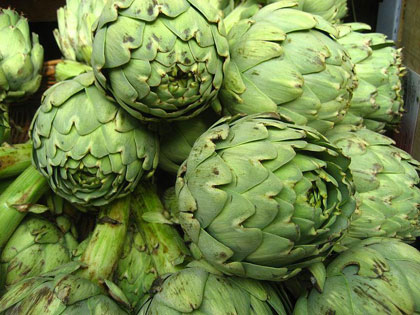
Artichokes, Wikimedia Commons (Jeremy Keith) 4. Artichokes (Cynara cardunculus)California produces 99.9% of all artichokes grown in the U.S., and artichokes are California's state vegetable. Water is essential to proper growth, and artichokes typically require 18-24 acre-inches per acre per year. Artichokes do not thrive in hot areas unless they are grown in partial shade, benefiting from the cooler climates near Santa Barbara and San Francisco. Artichokes have been used in studies trying to address water shortages in California by irrigating with recycled water. Studies found no major differences in the outcome of the crop. This could be a possible, partial solution to California's ever increasing drought difficulties. Artichokes have a low pesticide application rate of 0.27 pounds per acre, which is a good thing for people eating the artichokes as well as the workers in the fields. Artichokes are highly vulnerable to infestations of the native artichoke plum moth. Research has shown that pesticides can reduce infestations of artichoke plum moths from 80% to 2% of plants. Obviously, there must be a balance between what gives the best outcome for crops in terms of productions, and what is healthy for humans and the environment. 
Avocado, Wikimedia Commons (Petar43) 5. Avocado (Persea americana)Avocados are native to areas of Mexico and Central America with abundant rainfall. In California, avocados are grown in a more arid Mediterranean climate, thus they require irrigation or a lack of water will reduce yields. Because avocado trees are used to wet climates their roots do not search for water, which increases their need for irrigation. An avocado tree requires 40-50 inches of water a year. Avocados had a pesticide application rate of 3.06 pounds per acre in 2012. The University of California Cooperative Extension says of avocados: "The avocado orchards in California are under good biological control. Due to natural enemies, climatic conditions and good farm management practices, the avocado grower enjoys fewer pest problems than any crop grown in California."  Broccoli, Forge Garden, Santa Clara University. Broccoli, Forge Garden, Santa Clara University.
6. Broccoli (Brassica oleracea cultivar)California is the leading broccoli-producing state in the U.S., producing broccoli valued at more than $606 million in 2010 (AgMRC). Approximately 2-3 acre-feet of water per acre is needed to grow an irrigated broccoli crop in the Central Valley in California and about 1.5-2.5 acre-feet is used for broccoli production on the central coast during the summer. Water use is highest during the last month of the crop when vegetation growth is the highest. (University of California Vegetable Research & Information Center) The beet armyworm, cabbage aphid, and cabbage maggot are just a few of the many insects that can affect broccoli growth and production (UC IPM Online). Aphids and maggots burrow into broccoli heads and roots and can be difficult to manage. There are many natural enemies for these pests; however insecticides are often still used to lower pest populations. According to the University of California Statewide Integrated Pest Management Program, "[insecticide] use should be limited because they also kill the natural enemies that provide long-term control of aphids and other pests. They are also associated with bee kills." 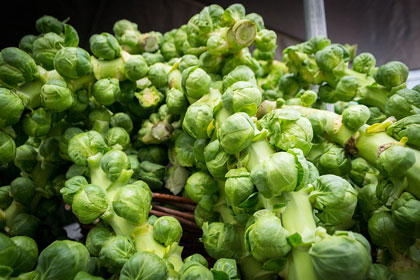 Brussels sprout on their stalks, Wikimedia Commons (Visitor 7) Brussels sprout on their stalks, Wikimedia Commons (Visitor 7)
7. Brussels Sprouts (Brassica oleracea cultivar)In the U.S., California is the leading producer of Brussels sprouts, which thrive in cool temperatures and coastal fog. Brussels sprouts are a water-intensive crop, using approximately 1 - 1.5 inches of water per week (NC State University). According to the USDA regional IPM Centers system, "Brussels sprouts plants grow to approximately three feet in height, with 80 to 100 sprouts at plant maturity. The complex morphology of the plant… provides many hiding places for aphids. This makes the crop so desirable to this pest, that it is sometimes planted at the borders of fields growing other crops to attract aphids away from those fields." Organophosphates are typically used as chemical control for insects, the most popular one being Chlorpyrifos, which is highly toxic.  Cabbages in a residential garden, California. Cabbages in a residential garden, California.
8. Cabbage (Brassica oleracea cultivar)Fresh cabbage production can be found in every state, with the top producing states being California, New York, and Florida. In 2010, California grew 13,200 of the 69,500 acres of cabbage in the U.S. (AgMRC). In 2006, the UC Vegetable Research & Information Center reported that in California there were 13,800 acres of cabbage being grown averaging about 22 tons per acre. The gross value of each acre was reported at $5,800. Like most crops, the water requirements for cabbage depends on the irrigation method, climate, and soil type. To germinate and grow cabbage, approximately 1-1.5 acre-feet (about 325,851 gallons) of water is applied. As much as 3.0 acre-feet (977,554 gallons) of water is used for cabbage produced under furrow irrigation in desert environments, and around 1.5-2 acre-feet is applied when overhead sprinklers are used for the crop (UC VRIC). Insect pest of cabbage include crickets, cutworms, beetles, and aphids. Pest management is crucial because a cabbage head is no longer marketable once an insect burrows into it. Insecticides are applied early and during head development in order to prevent infestation and to reduce any risk of lower crop yields. According to University of California Integrated Pest Management, "Natural enemies can be very important for controlling aphids, especially on crops not sprayed with broad-spectrum pesticides (e.g., organophosphates, carbamates, and pyrethroids) that kill natural enemy species as well as pests."  Carrots, Wikimedia Commons, (Jeremy Keith) Carrots, Wikimedia Commons, (Jeremy Keith)
9. Carrots (Daucus carota subspecies sativus)Today, California grows 80% of the fresh carrots harvested in the United States. The entire United States has a market for carrots that is valued at $609.5 million. Water use in carrots is very important for good root structure, taste, texture, and color; lack of water leads to poor tasting carrots and irregular or misshapen roots. For most of the growing season, carrots need about 1 inch of water per week. (Saskatchewan Ministry of Agriculture) Carrots have a very high rate of pesticide application. In California in 2012, carrots had a pesticide application rate of 11 pounds per acre treated, with over 7 million pounds applied across the state in total, including insecticides, rodenticides, fumigants, herbicides, fungicides, microbiocides, algaecides, nematicides, adjuvants, and surfactants. The history of carrots is an interesting case study in the development of a crop in the Unites States. They originated in Central Asia and the Near East, coming to this country in the seventeenth century with settlers. Originally there were many varieties of carrots and many colors, but since a majority of carrot production is run by two corporations in the US today, the varieties have lessened to only a small number. The industrial agricultural system has a large effect on biodiversity, as people choose and refine the crops they plant, lessening the natural protection and selection that comes with biodiversity. Should we as caretakers of the earth be doing more to preserve seed varieties?  Sour Cherry, Wikimedia Commons (Nicubunu) Sour Cherry, Wikimedia Commons (Nicubunu)
10. Cherries (Prunus avium and Prunus cerasus varieties)As with many US crops, California is a leader in cherry production. Most of the US Cherries are produced on the West Coast, with Washington, Oregon, and California producing the most. As a five-year average ending in 2000,Washington produced 86,000 tons of cherries per year and California produced 36,000 tons. Cherries, like other fruit and nut trees, are threatened by climate change because the trees need winter chilling. Without chill weather the fruit cannot form properly. This raises the question of whether California can, and should, continue to be a leader in cherry production or whether Oregon and Washington, which are cooler and wetter, should take on more of the demand. Cherry trees require about 6 years before they can produce fruit so adequate planning is required if production is to shift. In 2012, Cherry trees have an average application rate of 1.33 pounds of chemicals per acre per treatment, however, hidden in this statistic is that one acre may be treated multiple times per year. Total pesticide use on cherries in California in 2012 was almost 1.3 million pounds, over about 41,000 acres (PAN Pesticides Database). There are many potential and already existent issues around pesticide use in orchards. One of the most important and threatening is pesticide drift. Pesticide drift is the spread of sprayed chemicals via wind or other factors. These chemicals can find their way to homes, families, workers, and waterways. Pesticide drift is a serious issue in the Central Valley of California, where orchards are sprayed with numerous dangerous chemicals. It is ethically and morally wrong for workers and the environment to be negatively affected by pesticides drifting through the air.  Bitter oranges, Wikimedia Commons (A. Barra) Bitter oranges, Wikimedia Commons (A. Barra)
11. Citrus (Citrus species and hybrids)In California citrus trees are a large part of the agricultural economy. In 2012, California produced 34% of the citrus grown in the U.S., by contrast, 63% came from Florida. While citrus production is very good for the economy of California it is important to factor in the ethical implications of such a large industry. The climate in California is well suited for long growing seasons, but citrus trees require large amounts of water. The issue with growing citrus in California is that drought years are becoming increasingly common. Because water is becoming scarce it is important to look at water consumption among crops, and to see which are the most effective to grow in a region that is struggling to find enough water. According to the University of Arizona, citrus trees use about 60 inches of water per year, which for a large tree can be as much as 135 gallons per day in the summer. It is also important to understand that different crops require varying amounts of water, with some more intensive than others. For example lemons and grapefruits require 20% more water than an orange. The Central Valley of California is one of the premier tree-crop producing areas in the nation and yet this area suffers from severe groundwater overdraft problems. Looking at water use from the standpoint of human rights, humans have a right to water, thus while California is an important area for growing fruit, there must be a careful balance between agricultural and other uses of water. A second important issue to consider in California with regard to citrus is pesticide use. According to Eskenazi et al., 1999, "Children living in agricultural areas may be exposed to higher pesticide levels than other children because of pesticides tracked into their homes by household members, by pesticide drift, by breast milk from their farmworker mother, or by playing in nearby fields." The health of rural communities is at risk. This injustice can be traced to the chemicals which are administered to crops, including citrus trees. Although there has been pushback from sickened farmers, and the public in general, pesticide use in fruit trees did not decrease much in the last few decades. California uses 22% of the total agricultural pesticides in the nation; that's 85 million kg of pesticides used in just the year 2000. One solution to these problems may be organic agriculture since the use of these harmful synthetic chemicals is not allowed. Yet there is a lot to be done, as relatively little agriculture in California is organic.  Cotton bolls, Wikimedia Commons, public domain. Cotton bolls, Wikimedia Commons, public domain.
12. Cotton (Gossypium species)California's cotton is produced primarily in the San Joaquin Valley. Because of California's warm springs, hot summers, and dry falls, these regions have the perfect conditions for producing cotton. While California is not the top cotton producing state in the country (Texas takes that honor), there are still about 2-2.5 million bales of cotton produced per year in California on about 700,000 acres. This accounts for about 5-8% of the total U.S. cotton production. According to CALCOT, "the California cotton industry directly provides for over 20,000 jobs on farms, in gins, warehouses, cottonseed oil mills, and textile mills." Technological advances throughout the past couple decades have increased cotton productivity in the United States. In 2005, the most commonly grown cotton varieties in the U.S. were "biotech pest-resistant and/or herbicide-tolerant varieties," which accounted for "nearly 80 percent of total acreage." (AgMRC) According to industry sources, cotton's water use can be measured in inches per week, ranging from 0.6 to 2.0 inches per week. According to the World Wildlife Fund, "it can take more than 20,000 liters of water to produce 1kg of cotton; equivalent to a single T-shirt and pair of jeans." The same World Wildlife Fund study also stated that "2.4% of the world's cropland is planted with cotton and yet it accounts for 24% and 11% of the global sales of insecticide and pesticides respectively."  Sweet corn at the Forge Garden, Santa Clara University Sweet corn at the Forge Garden, Santa Clara University
13. Corn, Sweet (Zea mays)Corn has an ancient history in the Americas, with maize being grown as long as 12,000 years ago. Sweet corn is a mutation of field corn which appeared in the 1700s in Pennsylvania, and today is worth $1.2 billion across the US. Sweet corn is the variety which is canned, pickled and served for dinner. This type of corn is different than the type which is used as corn syrup, biofuels, and other uses. Fresh sweet corn accounts for nearly 70% of the market in the United States. California produces 16% of the nation's sweet corn. It is important to look at the water usage of such an important crop. Sweet corn's water use is substantial, using 1 to 2 acre-feet per season, although that is less than what is typical for field corn in a season. Like many vegetables, sweet corn is subject to intensive chemical dowsing in the industrial agricultural system. Yet there are alternatives to the conventional approach which are better for workers, the water, the earth the corn is planted in, and the animals who live near the fields. Some alternatives to insecticide on sweet corn are botanical insecticide, in other words more natural alternatives to chemicals, cutting the ends off the ears of corn to get rid of the pests who eat the corn, and mineral oil. While these solutions are skipped by most conventional farmers, they could offer good alternatives for a healthier agricultural system. 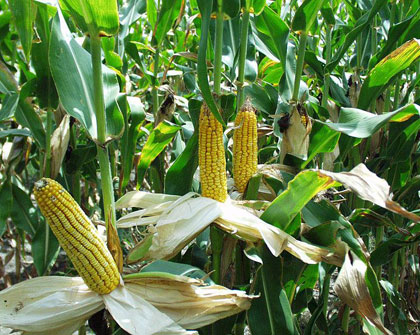 Corn, Madipally variety, Wikimedia Commons (vmcreddy) Corn, Madipally variety, Wikimedia Commons (vmcreddy)
14. Corn, Other Types (Zea mays)Corn is grown for a variety of uses in the United States, with some grown as food for humans while most of the corn in the Unites States is not eaten by humans, and is instead eaten by animals or turned into ethanol. A staggering 26% of U.S. corn is used for ethanol. Corn is the most widely produced grain for animal feed in the Unites States, and in California 75% is grown for this purpose. California's Central Valley accounts for 98% of the California corn production, with about 600,000 acres being grown. While the water use for corn varies slightly across the California Central Valley, the average non-sweet corn evapotranspiration is 25-29 inches per season. It is interesting that it takes more water to grow the crop that humans do not directly consume (non-sweet corn) than it does to grow sweet corn that we do directly eat. Is it ethically responsible of us to use so much water on a crop we only consume indirectly? Another issue that should be considered when discussing feed corn is whether it is appropriate to eat meat when so much water and energy has to go in to the production of one head of cattle. Cattle and other animals, by eating corn, consume vast quantities of water and energy that could otherwise support humans. Additionally, animals must themselves be watered, fed, cleaned, etc. All of this means it is much more water and energy intensive to eat meat than it is to eat plant products directly. Water pollution is a huge problem which stems from corn production across the United States. The problem is especially bad in the Upper Mississippi River watershed. The collected fertilizers and pesticides which are used on the vast expanses of corn farmland across the heart of the United States drain through the Mississippi River Basin which covers 40% of the contiguous United States. The concentration of so many pollutants have poisoned the waterways of this section of our country and created a massive "Dead Zone" in the Gulf of Mexico where life can't survive because of the lack of oxygen caused by the pollutants (UCSUSA).  Eggplant in a residential garden, California. Eggplant in a residential garden, California.
15. Eggplant (Solanum melongena)California is one of the top producers of eggplants in the country. In 2009, over 17,300 short tons of eggplants were harvested, valued at around $11 million. Eggplants are warm-seasons crops that do not tolerate frost, which makes California a prime location for production. (AgMRC) Eggplants can either be grown with furrow or drip irrigation. The amount of water used typically depends on the time of year and stage of plant grown. Furrow irrigated eggplants use about 1.5 acre-feet of water per season. Several insect pests are drawn to eggplants, including spider mites, aphids, and flea beetles. Acetamiprid is a neonicotinoid insecticide commonly used with eggplants to manage pests. According to the U.S. Environmental Protection Agency, when it comes to human health, acetamiprid "May be fatal if swallowed, absorbed through the skin, or inhaled. Causes eye injury." Additionally, acetamiprid is toxic to wildlife including honeybees, thus adding to the already strained health of honeybees in the world, which are suffering from Colony Collapse Disorder (EPA).  Fig, from Plant Illustrations, public domain image by C.J. Trew, Plantae selectae quarum imagines ad exemplaria naturalia Londini, in hortis curiosorum nutrit, vol. 8: t. 73 (1771) [G.D. Ehret]. Fig, from Plant Illustrations, public domain image by C.J. Trew, Plantae selectae quarum imagines ad exemplaria naturalia Londini, in hortis curiosorum nutrit, vol. 8: t. 73 (1771) [G.D. Ehret].
16. Figs (Ficus carica)According to the National Agriculture Statistics Service, California ranks first in the nation in fig production, accounting for nearly all of the figs produced in the U.S. As of 2012, California produced 38,700 tons of figs (AgMRC). Fig production is a water intensive process. Figs have a tough time tolerating sites with poor drainage because if their roots become flooded they don't intake enough oxygen, which can kill the tree. Droughts can also cause figs to under-produce or die, thus necessitating irrigation for successful fig production. An average fig tree needs about 1 to 1.5 inches of water every week from rain and irrigation combined, as recommended by the University of Georgia's College of Agricultural and Environmental Sciences. Lack of water can result in weak growth and sparse foliage. Irregular watering may cause the fruit to split. Figs have a number of insect pests that can ruin a crop yield and kill the tree entirely. These insects include the dried fruit beetle, fig scale, navel orangeworm, and vinegar flies. Fig farmers use both chemical and non-chemical practices to handle their pest problem. Some non-chemical practices include placing diced fermenting or decaying fruit near the trees to reduce the insect population or introducing parasitic wasps that will only target other insects and not the fruit. Chemical practices include spraying pesticides such as aluminum phosphide and piperonyl butoxide/pyrethrins. Aluminum phosphide is very lethal and has caused human deaths in areas where it is used.  Garlic and onion, Wikimedia Commons (Magnus Manske) Garlic and onion, Wikimedia Commons (Magnus Manske)
17. Garlic (Allium sativum) and Onions (Allium cepa)California is third in onion production and number one in garlic production for the United States. There are vast expanses of land devoted to these crops each year. Evapotranspiration in onions varies with location, but in Eastern Oregon, for example, evapotranspiration is about 28 - 32 inches. Green onions use less water; in California, water use for green onions is about 12 - 20 inches. Onions require frequent irrigation, and even moderate drought stress can cause problems for the crop. Total value of the U.S. garlic crop in 2013 was $232 million. Garlic plants, like onions, are shallow rooted, are grow best in light soils. Onions have a pesticide application rate of 1.56 pounds per acre. A study done by an Organic farm and education center in Vermont found that of the 169 pesticides used on onions, 54.5% are highly toxic. The most popular use for these pesticides was to treat the soil after the onions had grown so that other crops could be planted on the same soil the following year. The most popular chemical used for this process is metam-sodium, which decomposes into the highly poisonous methyl isothiocyanate.  Malbec grapes, Wikimedia Commons (Ian L) Malbec grapes, Wikimedia Commons (Ian L)
18. Grapes (Vitis vinifera varieties and related species)California is well known for its wine industry, and in 2004 grapes for wine made up 8.7% of all agricultural receipts from California. Overall, in 2012, over 7.3 million tons of grapes were grown in the U.S. with over 90% of that grown in California (AgMRC). Naturally a large enterprise such as this has a large environmental impact. In a typical non-drought year, agriculture in California uses approximately 75% of the state's total developed water supply. Water use in winegrape production varies considerably. In California's North Coast area it takes "75 gallons of water to grow the grapes for one gallon of wine," but that number jumps to 430 gallons to make one gallon of wine in the vineyards of the Central Valley (The Wine Economist). As the availability of water drops and it becomes harder for all needs to be met, the war over the nature of water as a right will become fiercer. Many have the firm belief that access to safe water is a human right. California wine grapes used a total of 26 million pounds of chemicals in the year 2012. According to the U.S. Department of Agriculture, of all the grapes grown in California in 2011, 70% received fungicides, 39% received insecticides, 49% received herbicides, and 37% received other chemicals. This extensive use of harmful chemicals has profound impacts on the health of the land, people, and animals which live in and around the agricultural land where these grapes are grown. It is not ethically just to allow our agricultural practices which produce food and wine to degrade the earth in the way they currently are. It is also wrong because from an environmental justice standpoint farm workers are bearing an unequal and unjust burden in relation to the chemicals applied to crops.  Lettuce Heads, Wikimedia Commons (Dwight Sipler) Lettuce Heads, Wikimedia Commons (Dwight Sipler)
19. Lettuce (Lactuca sativa)Lettuce-based salads are a staple in restaurants and on dinner tables across the world. Lettuce is a $1.9 billion industry in U.S., and California and Arizona account for 98% of all U.S. production. A serious issue for agriculture in California is water availability. As droughts continue increase in California water rights are becoming a contested issue. The amount of water used to grow lettuce in California varies from 1 - 3.5 feet of water per planted acre depending on location (coastal, inland valley, or desert) and watering method (drip, furrow, or sprinkler). Lettuce is normally planted in the middle of summer for a late fall harvest, and in late fall for an early spring harvest. For this reason water use is different depending on when it is planted. About 20% less water is used when lettuce is planted in late fall and harvested in spring. Lettuce does not have a proportionally high application rate for chemicals, only 0.4 pounds are used per acre treated, but while this is not a large number compared to other vegetables, unlike an orange which may be peeled, lettuce cannot be peeled. The surface onto which pesticides are applied is directly eaten. The only way that chemicals can be cleaned off is to wash the lettuce, so if one buys lettuce that is not organic it ought to be washed.  Cantaloupes, Wikimedia Commons, USDA public domain image Cantaloupes, Wikimedia Commons, USDA public domain image
20. Melons (select species of the family Cucurbitaceae)California ranks number one in the nation in both cantaloupe and honeydew melon production. The market values of cantaloupe and honeydew produced in the U.S. in 2013 were $319 and $75.4 million, respectively. The market value of U.S. production of watermelons (which are primarily grown in Florida, Georgia, California, and Texas) in 2012 was $520.8 million. Water use for melons differs based on the grower and what technique they use to water their crops. Cantaloupe for example may consume 10-15 inches of water in a season. The most water efficient methods is drip irrigation, which also helps melons because there is no excess water for weeds to consume. Most melons in California are grown in raised beds which can reduced the water loss for crops as well as increase drainage which is helpful. Melons do well with long warm growing seasons so are well suited for California's environment. Many of the cantaloupes grown in California are destined for Japanese markets. These are expected to be blemish free, and as a result there is an extremely high use of pesticides on these melons to achieve the standard necessary for export. This raises the question of whether it is right to risk harm to the workers and environment in California with dangerous chemicals, and then export the commodity overseas. 90% of all melons in California are sprayed with insecticide, and more than 80% of melons are sprayed with fungicide. (IPM Centers)  Pear tree, Wikimedia Commons (Alborzagros). Pear tree, Wikimedia Commons (Alborzagros).
21. Pear (Pyrus species)The California Pear industry produces about 25 % of all pears grown within the United States and adds $80 million to the state's economy. According to a 2011 survey of California pear farmers, the average pear farm in California is around 130 acres in size and there are currently 60 pear producing businesses within the state, each with pear trees averaging in age between 33 and 100 years old. Each year around 200,000 tons of pears are produced in California, with Canada and Mexico receiving over 80% of pear exports (California Pear Advisory Board). Pear trees are self-pollinating and are harvested in California in mid to late June. Northern California provides optimal conditions for pear growth with its warm days, cool evenings, and rich soil. Pears are rich in vitamin C, fiber, and potassium, making it a great snack food or juice ingredient. Although the pear industry is relatively small compared to the state's other fruit industries, the trees still requires a fair amount of water. This is especially true when the trees are blooming in the spring and when the fruit is developing in late summer. Established trees need deep soakings when they get watered. The California Pear Advisory Board reports that, of those farmers who metered their water and recorded their water usage, pears used an average or 25.71 acres-inches of water in 2012 to irrigate their pear orchards. Pear farmers in California use some of the most environmentally-friendly pest control practices. These tactics include pheromone traps, the incorporation of beneficial insects, and reduced-risk pesticides designed to target specific pest when integrated pest management tactics are not enough. 97% of pear farmers in California use pheromone traps to monitor pest population. Organophosphate and carbamate compounds are California pear farmers most highly restrictive category of pesticides. The California Pear Advisory Board reports that over the past 12 years, pear farmers have reduced their use of these compounds by about 91%. 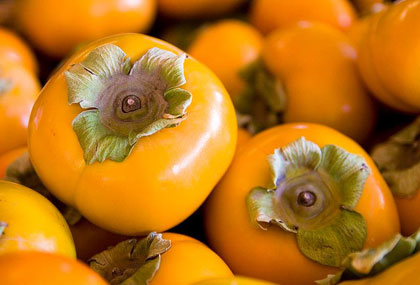 Persimmons, Wikimedia Commons (Angelo DeSantis). Persimmons, Wikimedia Commons (Angelo DeSantis).
22. Persimmon (Diospyros species)Because California regularly experiences droughts it is important to grow crops which are suited for less water. According to the California Rare Fruit Growers, a typical tree needs 36 to 48 inches of water annually. Persimmons can withstand short periods of drought and require less water per year than citrus trees. Thus, growing persimmons would provide a relative water-conservation advantage since they are less water dependent than citrus. As water scarcity increases in much of California, it becomes an ethical decision to decide what crops are best suited for the environment. Persimmons are relatively free of pests and diseases. For example, persimmons had an application rate of 4.6 pounds of chemicals per acre per year in 2012 (5,420 pounds over 1176 acres planted). Oranges on the other hand had an application rate of 50 pounds per acre per year in 2012 (8,839,960 pounds over 176,602 acres planted), a much higher number. Human health, especially of workers and their families, is impacted by pesticide use, and it is important to know that some crops are treated more or less than others. Another ethical impact of agriculture is land degradation. Soil can be lost by erosion or can be otherwise degraded by leaching of nutrients or buildup of salts and/or other chemicals. It is wrong to degrade the land and endanger our future ability to grow the food that we need. Fruit trees in general are good for preventing land degradation, and are often a solution rather than a problem. In many cases soil erosion is controlled with fruit trees and they do not require crop rotation, and so last for many, many seasons in the same location. 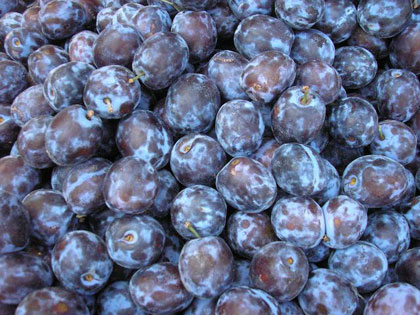 Plums, Wikimedia Commons (Maciarka) Plums, Wikimedia Commons (Maciarka)
23. Plum (Prunus species)California is the largest producer of plums in the United States. According to the AgMRC, "in 2010 the state produced 141,300 tons of plums from 26,200 acres of land" at a value of $78.4 million. The number of acres of plums in California has decreased from 42,000 acres in 1997 to 26,200 acres in 2010. According to the University of California, Davis, mature plum trees use approximately 44 inches of water per year. This statistic includes rainfall, so the amount of irrigation needed will equal 44 inches minus whatever rain may fall that year. (UC Davis Cost Studies, Plum PDF) Overall, in California in 2012, plum orchards reported using 731,502 pounds of pesticides over 23,172 planted acres, for an application rate of about 31.5 pounds per acre per year (Pesticideinfo.org). The vast majority of applied pesticide (521,942 pounds) was unrefined mineral oil, which (unlike refined mineral oil) is carcinogenic. Among the more potent pesticides used on plums, the organophosphate insecticide diazinon (an acetylcholinesterase inhibitor) can be used to kill insects such as the American plum borer (UCIPM).  Pomegranate, Gottorfer Codex, 1649-1659, plantillustrations.org Pomegranate, Gottorfer Codex, 1649-1659, plantillustrations.org
24. Pomegranate (Punica granatum)With severe droughts always being a part of California's future, fruit trees that depend on less water are more logical and more ethically favorable. Pomegranates have been identified as a promising crop in California because of their nutritional value, their drought tolerance, and their salinity tolerance (Ayars et al.). Although pomegranates require about the same amount of water as citrus trees in order to produce large crops of good-quality fruit, pomegranates can withstand drought. That means that while still being water intensive during years when water is available, in years where water is less available at least the trees will not die, just produce less fruit, and the trees will recover when the drought ends (UC Davis). These are the types of considerations that are increasingly important in a changing world. Although pomegranates have a promising future when it comes to water consumption, they are chemical-intensive. In 2012, California's 33,177 acres of pomegranates had 669,281 pounds of pesticides applied to them, yielding a pesticide application rate of 20.1 pounds per acre per year. Most of the applied pesticides were inorganic sulfur and kaolin. For comparison, while this application rate is less than the rate of pesticides to plums, it is much more than the application rate to persimmons.  Rice, Wikimedia Commons, public domain. Rice, Wikimedia Commons, public domain.
25. Rice (Oryza sativa)The United States grows over 2.7 million acres of rice worth nearly $3.0 billion, of which $2.1. billion worth is exported. Arkansas leads the nation in rice production, with 46% of the nation's crop, worth $1.4 billion, while California is second in production, with 26% of U.S. production worth $770 million. (AgMRC) As might be expected for a crop grown in flooded fields, rice is a very water-intensive crop. Depending on the soil type (whether it is sandy or clay, sand requiring more water), rice uses 24 and 48 acre-inches per season. Yet at the same time, rice is extremely productive, producing about 8,000 pounds per acre. As a crop, rice also allows for utilizing fields that might otherwise be too swampy for normal crops, and flooded rice fields also provide habitat for birds. On the downside, flooded rice fields also release methane which contributes to global warming. From an ethical standpoint, crops must all be judged relative to each other in terms of their specific and differing costs to the local environment as well as the larger environment, keeping in mind human need for food. Rice is not only water intensive but also pesticide intensive. One acre of rice uses about 10 pounds of pesticides per season (5.3 million pounds over 530,000 acres). According to the U.S. Geological Survey, some of these pesticides, such as molinate and thiobencarb (which were detected in all water samples), escape into the Sacramento River in quantities that exceed water quality goals. What should be the acceptable level of pesticides in such important waterways?  Strawberries, Wikimedia Commons, public domain. Strawberries, Wikimedia Commons, public domain.
26. Strawberry (Fragaria × ananassa)The United States produced over 1.3 million metric tons of strawberries in 2012, making it the world's largest producer. United States strawberry production accounts for 29% of the total world strawberry production. The California Strawberry Commission reported 37,425 harvested acres in 2011. Most of California's strawberry farms are in southern and/or coastal areas. Irrigation for strawberries in the Pajaro and Salinas valleys averaged 21 inches, but ranged widely, from 10 to 37 inches. Methyl bromide is a controversial fumigant widely used in strawberry production in California. It is used to reduce or eliminate soil-borne pests and diseases, but is also associated with the depletion of the ozone layer. Methyl bromide was one of the most widely used fumigants in the world. The use of the chemical was phased out on January 1, 2005, in accord with the Montreal Protocol on Substances that Deplete the Ozone Layer and the Clean Air Act. Currently, methyl bromide can only be used for critical exemptions such as for growing strawberries. 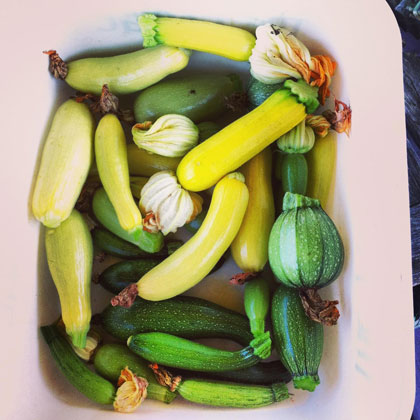 Summer squash, Forge Garden, Santa Clara University. Summer squash, Forge Garden, Santa Clara University.
27. Summer Squash / Zucchini (Cucurbita pepo varieties)Summer squash is a warm season crop that grows well in almost all areas of California, though it grows especially well in the southern desert areas of the Imperial Valley, the Central Valley and the south-central coast (UC Davis ANR Catalog). Summer squash include zucchini, crookneck, straightneck, and scallop type squashes. Summer squash are related to winter squash but differ in that they are usually eaten before maturing and developing a hard shell. In 2013, the United States grew 630 million pounds of squash (both summer and winter) valued at $237 million. Florida leads the nation in squash production, followed by California, New York, and Michigan (AgMRC). At least 18 acre-inches of water is required for summer squash plants over the season. Too much water may cause problems with rot; too little water may damage the fruit. Armyworms are known to damage summer squash crops and are generally hand-picked or treated with the insecticide spinosad. Spinosad is considered a natural product and approved for use in organic agriculture.  Tomatoes, Forge Garden, Santa Clara University. Tomatoes, Forge Garden, Santa Clara University.
28. Tomatoes (Solanum lycopersicum)The US tomato crop is typically divided into fresh and processing tomatoes. In 2010, more than 1.4 million tons of fresh tomatoes (28.9 million cwt) were produced in the United States, while 12.8 million tons of processing tomatoes were produced. California leads the nation in production in both categories, but by a much larger margin in processing tomatoes, where it produces 96% of the U.S. crop. In California, all fresh-market tomatoes are irrigated, either by surface drip, subsurface drip, or furrow irrigation. Between 20 and 36 inches of water are applied per acre in a season, depending on various factors such as type of tomato, climactic conditions, and soil. Drip irrigation is more efficient and allows hand harvesting the fields at regular intervals. (UC Davis ANR Catalog) Tomatoes use a lot of pesticides. In 2012, 36 pounds per acre of pesticides were used on tomatoes in California (1,377,200 lbs over 38,164 acres). Though the largest single pesticide used is sulfur, which is not particularly harmful, the next three most commonly used pesticides are metam-potassium, chloropicrin, and metam-sodium, which are all PAN "Bad Actor" pesticides, meaning they are particularly toxic. |
Javen Kizzart and Sulaiman Shelton
Oct 28, 2015
--
